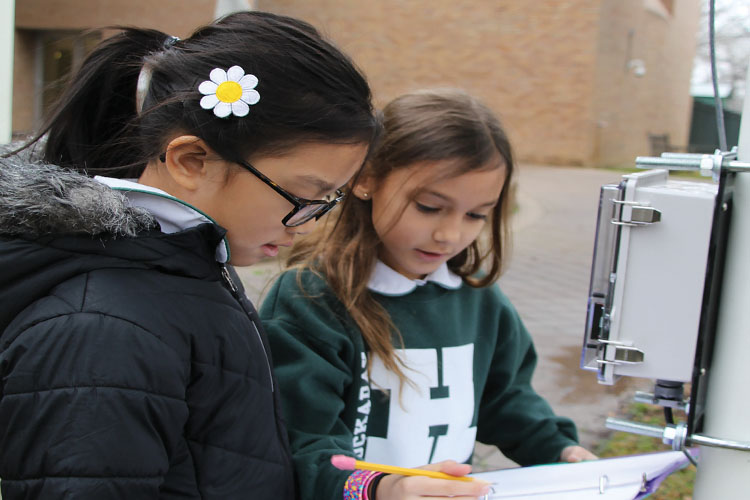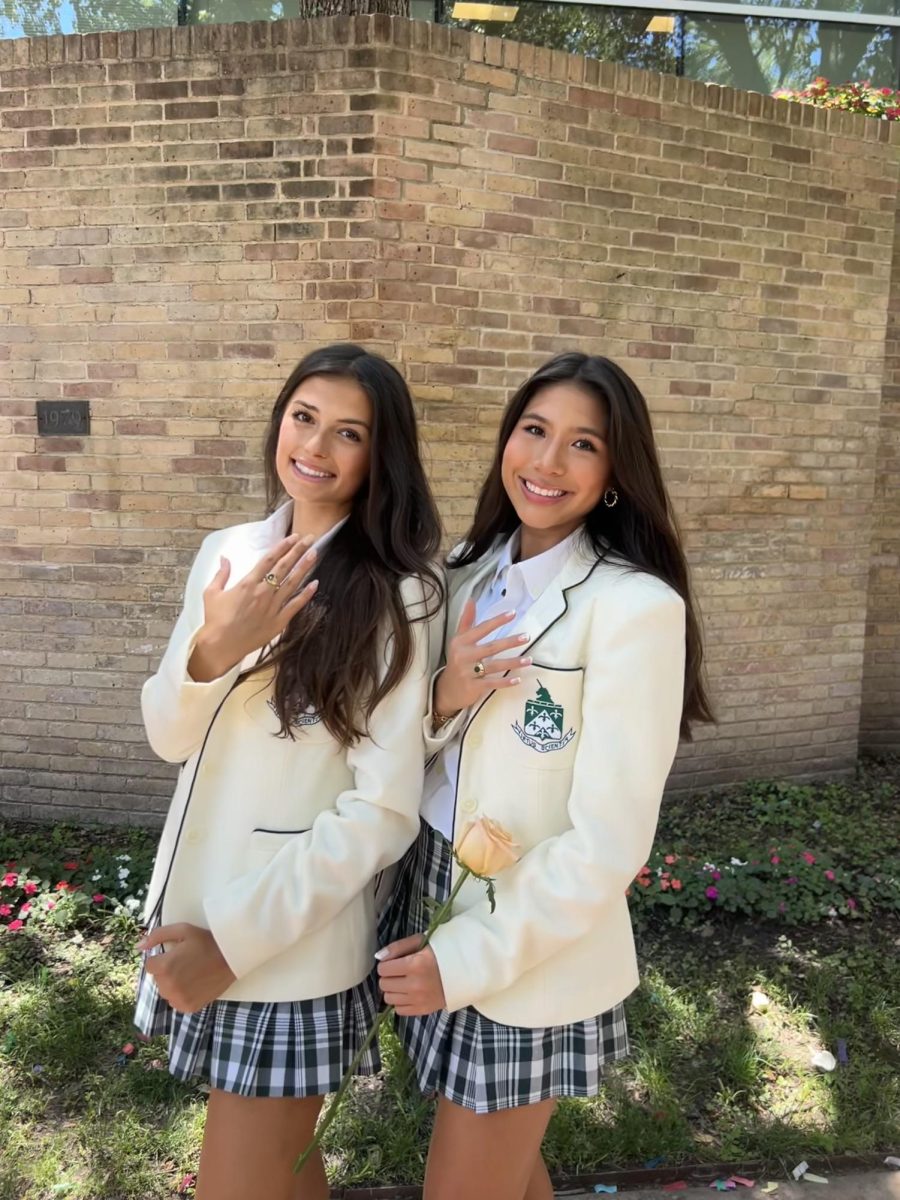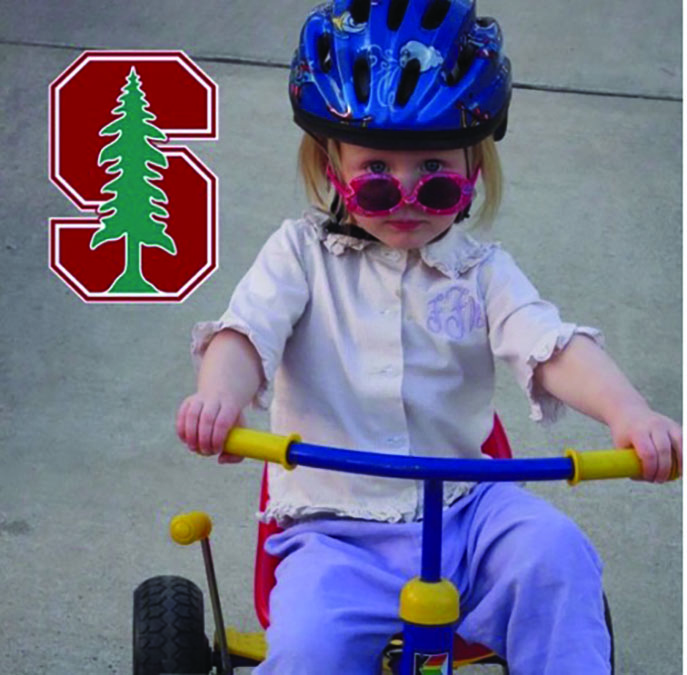PICTURED ABOVE: Second graders Chloe Ku (left) and Ella Wing (right) measure the air pollution by using loggers that are set up by the Lower School Playground. Each second grade student gets the leadership opportunity to record the data as they apply their science knowledge to real-world situations.
Lower School students are taking a new approach to learning by focusing on solving real-life problems. From minimizing their food waste to measuring air pollution emitted by the carpool line, the students are working on improving the community one project at a time.
Randal Rhodus, Head of Lower School, stresses the importance of service in community and positively affecting the environment to Lower School students.
“We really want our girls to lead change,” Rhodus said.
Director of The William B. Dean Service Learning Program Laura Day emphasizes the institute of social impact; therefore, the Lower School decided to implement changes in their service projects this year.
“We’re trying to make bigger [projects] so that [the students] can really make a change,” Rhodus said.
They kicked off their year of change by focusing in on food waste. Michelle Goldsmith, Technology Integration Specialist, noticed that the girls were throwing away excessive amounts of food.
“I spent a few days observing and taking pictures of how much food they were throwing away, and what they were taking and not eating,” Goldsmith said.
Goldsmith wanted the students to become more aware of their of food waste, so the Lower School teachers partnered with SAGE Dining Services and asked them to weigh the Lower School trash. The first day that they weighed the food waste, the total came out to be 144.3 pounds after one Lower School lunch.
Claire Bolden, fourth grader, realizes just how much food the Lower Schoolers were wasting each day.
“The whole Lower School was definitely wasting a lot of food, and [they] didn’t even really realize it,” Bolden said. “But when Ms. Goldsmith took a picture of the trashcan, we began saving a lot of food.”
After sharing the information and images with the Lower School girls, they began to brainstorm how they could reduce food waste. For instance, Bolden looks at the menu every morning to decide what she will want for lunch. Siena Ebert, fourth grader, chooses less items when she goes through the lunch line.
The whole Lower School began to become more aware of their food waste, so SAGE weighed the trash the following week without warning the students. They reduced their food waste significantly, and after the second time it only weighed 76.5 pounds.
“We all changed our habits and behaviors,” Rhodus expressed. Together, they made a collective impact.
Not stopping there, the second graders began to tackle problems affecting the environment.
A second-grade parent brought the Environment Protection Agency’s “Idle-Free Schools” program to Rhodus’ attention.
Day asked Amy Banks, Lower School science teacher, if there was any way to engage the second grade students; therefore, the air pollution project began.
As parents wait at school carpool pick-ups, their cars produce large amounts of pollution.
“The theme for the second grade social impact efforts is the environment, so this seemed like a good fit,” Banks said.
Science Department Head Marshall Bartlett and Banks spoke to the students to initially introduce the project and teach them about the effects of air pollution.
“Air pollution is an idea kids can understand easily,” Banks said. So they decided to test the pollution resulting from the carpool line.
By testing the air, the girls are practicing science out of the classroom and in a real world situation that is ultimately affecting their lives.
“Our students are the ones that are waiting [outside after school], so they are the ones that breathe in this air every day,” Rhodus explained.
Essentially, the project consists of this: the students set up two loggers to track the amount of pollution released by cars—one outside the Liza Lee Academic Research Center and Forest Lane entrance and one placed by the Lower School playground.
“The loggers are recording a suite of meteorological data—temperature, pressure, humidity, etcetera—and the air quality by monitoring volatile organic compound levels and particulate concentrations,” Bartlett said.
Each girl gets the leadership opportunity to record the information from the pollution readers.
From here, it is up to the girls to see what they will do with this information: possibly creating the “Idle Free-Zone” in the carpool area or presenting the information to the students and adults in the Hockaday Lower School.
The Lower Schoolers shifted the focus on their community service projects and ended up creating greater impact, not only on the Hockaday community, but the world as well.
“The hope is that the girls have experience in all different layers of service,” Rhodus said.
So now, the question lingers: what future plans do the Lower School students have to lead change and promote awareness of food waste and pollution for the rest of the school?
Story by Kate Clark, Staff Writer
Photo by Ileana Kesselman








